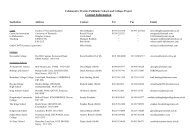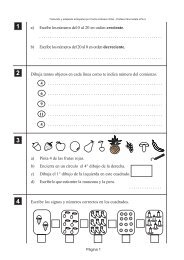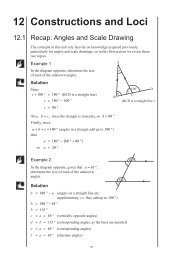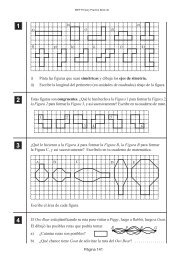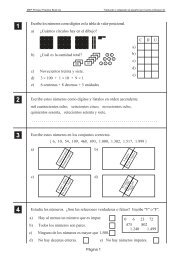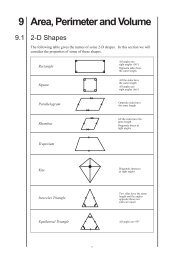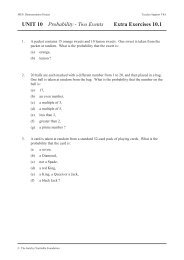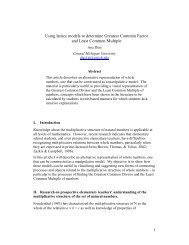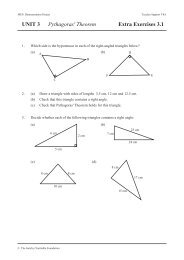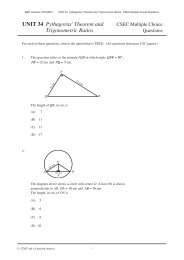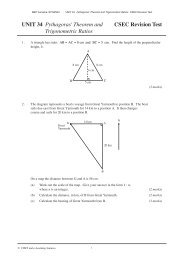It's CAME; We saw; Did it Conquer? – A review of the Cognitive ...
It's CAME; We saw; Did it Conquer? – A review of the Cognitive ...
It's CAME; We saw; Did it Conquer? – A review of the Cognitive ...
You also want an ePaper? Increase the reach of your titles
YUMPU automatically turns print PDFs into web optimized ePapers that Google loves.
At <strong>the</strong> end <strong>of</strong> <strong>the</strong> academic year 2003/2004 four schools had completed <strong>the</strong> two year<br />
pilot project. A sample, to participate in <strong>the</strong> pilot study, <strong>of</strong> one grammar school and<br />
one non-grammar school was made by <strong>the</strong> BELB from <strong>the</strong> in<strong>it</strong>ial group <strong>of</strong> four<br />
schools. A control sample <strong>of</strong> two non-<strong>CAME</strong> schools, one grammar and one nongrammar,<br />
was chosen by <strong>the</strong> BELB.<br />
W<strong>it</strong>hin each <strong>of</strong> <strong>the</strong> four schools participating in <strong>the</strong> pilot study, two year 9 classes<br />
were administered <strong>the</strong> ‘Myself as a Learner Standardised Scale’ (MAL) (2002).<br />
Burden (2000) perceives this as an information ga<strong>the</strong>ring instrument and comments<br />
that adolescents have responded pos<strong>it</strong>ively to <strong>the</strong> nature and purpose <strong>of</strong> <strong>it</strong>. The results<br />
were in<strong>it</strong>ially analysed using <strong>the</strong> MAL scale suggested by Burden. Fur<strong>the</strong>r analysis<br />
using <strong>the</strong> Mann-Wh<strong>it</strong>ney U-test was <strong>the</strong>n carried out. This is an inferential nonparametric<br />
test for significance and <strong>it</strong> was deemed appropriate for this data because <strong>of</strong><br />
<strong>it</strong>s su<strong>it</strong>abil<strong>it</strong>y for data w<strong>it</strong>h a small sample size and where <strong>the</strong>re may not be a normal<br />
distribution.<br />
In add<strong>it</strong>ion, each school provided <strong>the</strong> researchers w<strong>it</strong>h a small group <strong>of</strong> approximately<br />
six pupils who participated in a taped group interview. As <strong>the</strong> interviewees were<br />
children <strong>it</strong> was hoped that <strong>the</strong> group interview would be less intimidating and would<br />
encourage a variety <strong>of</strong> ideas and responses. The interview questions were presented in<br />
a standardised semi-structured format.<br />
In <strong>the</strong> two <strong>CAME</strong> schools and <strong>the</strong> two control schools <strong>the</strong> class teachers participated<br />
in a standardised semi-structured taped interview. Prior to recording, <strong>the</strong> teachers<br />
were inv<strong>it</strong>ed to <strong>review</strong> <strong>the</strong> questions and where <strong>the</strong> researchers felt <strong>it</strong> appropriate, <strong>the</strong>y<br />
explored fur<strong>the</strong>r comments and issues raised by <strong>the</strong> teachers’ responses. In add<strong>it</strong>ion,<br />
<strong>the</strong> Head <strong>of</strong> Ma<strong>the</strong>matics in each <strong>of</strong> <strong>the</strong> schools was inv<strong>it</strong>ed to respond to issues<br />
relating to whole school policy matters.<br />
Results<br />
Teaching Methods<br />
The teaching staff in <strong>the</strong> schools participating in <strong>the</strong> <strong>CAME</strong> project felt that <strong>the</strong>ir<br />
teaching methods had been affected pos<strong>it</strong>ively by involvement. The use <strong>of</strong> group<br />
- 7 -



